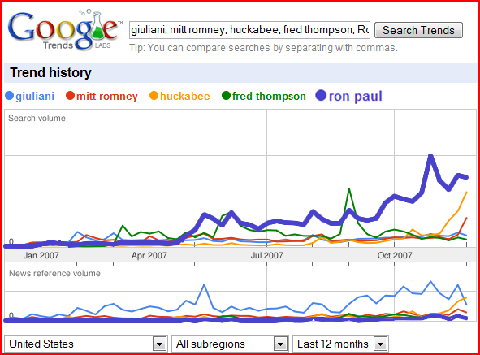Visitors to My Blog
Back in 2004 I created a web statistics tool I called Twinkle Maps. It would show views to a page on a map over time so it looked like little lights twinkling across the map. This was exceptionally good for tracking viral spread. I’ve stopped using that tool since Google Analytics handles a bunch of other things as well as a map component. It’s not as useful for viral marketing analysis but it does more than what I need on a daily basis.
I look at the analytics once a day and study them in more detail once a week. I’ve found some fascinating results. Today I found someone using MSN with the search term “red dwarf” visited my blog. I posted an article about the BBC and Creative Commons licenses that mentioned Red Dwarf and that is what the person found. It seemed odd that the person would find my blog based on that search term so I tried the search myself. My site does not show up on the first 32 pages. How far down the search was the person looking?
Raser Inc. has visited my blog 4 times, once going to the contact page but they didn’t contact me. Why? Only 10% of people that go to the contact page contact me. Perhaps they were looking for my phone number. I added my phone number, lets see how many calls I get.
I get a lot of traffic from universities. Here are all the universities and colleges that visited my blog this year.
Revealing Emerging Expectations, the most important step of innovation.
Emerging expectations are the things customers will start to demand next. These are features, benefits, and values current products are missing but customers haven’t started demanding yet. When customers realize these desires can be met they will demand it from all future products. It’s essential to have something ready when that happens or you will lose customers.
Working on things customers are already asking for puts you in a race with others. If you try to meet existing desires you are in a race against time. Even if you make it to market first, your advantage will quickly disappear. Others will develop competing products, if they haven’t already been working on them. If you don’t have the next product ready your innovation will be overwhelmed with copycats that make improvements on your design.
Revealing emerging expectations allows you to work two steps ahead so you always have the next great thing perfected and ready to release when the demand is strongest and profits are greatest. Plus if you can accurately predict the future innovations you will be able to overwhelm competitors with improvements faster and with less expense than they can copy you. You get ahead, stay ahead, and increase your lead.
Just because you can make it doesn’t mean customers will want it. To get the best return on investment you need to choose the innovations customers will do anything to get. And even if it’s something customers want it doesn’t mean its right for you to sell. So the innovation system you use must reveal a large selection emerging expectations, preferably all, and provide a way for you to compare and rank them in order of value to you.
Many people can think of pie in the sky “futuristic” products. Science fiction is full of those types of ideas. Some of those sci-fi products actually do become real products and are successful. The question is, when? Absolutely predicting the future is impossible but understanding the land marks to watch for gives you the information to plan your actions. If a new product depends on other developments then you should wait for those to be released before releasing yours. You can have everything ready to go and jump into the market at the exact right time. You maximize profits and minimize risk. A complete innovation system shows you those land marks with enough lead time to act.
Revealing the emerging expectations is what makes the OutCompete Predictive Innovation Method predictive and not just another feel good innovation system. The way it does this is by using certain laws of systems that apply to every system. Understanding that every system must follow certain laws allows you to see which things will become “must have innovations” and the order it will occur.
Ron Paul Viral Marketing Success
Ron Paul is winning popularity portion of the united States presidential election. He consistently speaks the truth and does what he says. And lucky for Ron Paul the truth makes a lot of people so happy they sell his message for him.
I pioneered viral media on the web. And have since moved beyond viral to a broader more accurate term, evangelism. Its clear Ron Paul has a lot of evangelists. All of his success is from normal people spreading the message all on their own.
Part of my research on viral / evangelistic marketing is what the trends mean and how to get the results you want. Looking at the trends for Ron Paul and the other candidates I see some very striking results.
Google Trends is accurate unbiased data on what real people actually care about. According to Neilsen/NetRatings 232 million Americans use the Internet. That makes Google Trends the largest most accurate measure in the world.

First, Ron Paul (dark blue line) has more searches than than any other candidate. Plus his searches is continually growing. This is suggestive of real wide spread support. There are 7.7 million pages on Google for Ron Paul.. That is almost 4 times as many as Mitt Romney. Ron Paul has more pages about him, which confirms support not just interest. There are other measures I use and will explain those in future posts.
Romney (orange line) has no real support. You can see this from how his traffic jumps then immediately falls to nothing. He depends on events to get any interest. If Romney was a company I would short his stock. His advertising works but Romney is a bad product.

Hillary Clinton (the red line) is suffering from the same problem as Mitt Romney. She gets big spikes but people don’t like her and try to forget her as soon as possible. Even with a huge budget and over 16 years of national media attention there are only 5.8 million pages talking about her. And much of that is criticism. Hillary Clinton is the political equivalent of Paris Hilton. She gets attention when she does something insane but loses popularity every time.
Barack Obama is in bad shape. Notice that he got a big jump when he announced he was running for office but his traffic has consistently gone down. With only 2.8 million pages and downward trend Barack Obama he is far behind the leader, Ron Paul. The fact Obama doesn’t get any new jumps means its unlikely he will gain any support. He could linger around for a long time but will have a hard time getting new attention. He is played out.
My Suggestions
Hillary has total name recognition. Since people react so negatively she can’t really benefit from Evangelism Marketing without doing something very different. With her long track record she would face the credibility issue if she tried to be different. She depends on spending huge amounts of money and favorable treatment from the big press to get attention.
Romney is dead in the water. He needs to find something unique that he actually deliver. Unfortunately that would require going back in time. He can’t deliver anything unless elected.
Obama can make it to the election with his current trend. He needs to find a new audience, which is unlikely since he already had a huge jump in the beginning. If he offers something new that might get more attention.



 Predictive Innovation Training
Predictive Innovation Training Predictive Innovation: Core Skills Book
Predictive Innovation: Core Skills Book RoundSquareTriangle.com
RoundSquareTriangle.com